
The structure of your home is more than just walls and a roof — it’s the system that keeps everything safe, stable, and standing. But unlike leaky faucets or flickering lights, structural issues often whisper before they shout. So how can you determine when it’s time to take a closer look?
Let’s break down the key signs that may warrant a structural inspection and what that process involves.
Recognizing the Red Flags
A structural inspection isn’t something homeowners need every year. But when certain symptoms appear, it’s worth taking them seriously.
- Cracks That Tell a Story
Not all cracks are cause for concern. Hairline cracks in plaster or drywall can result from natural settling. However, wide, jagged, or diagonal cracks — especially those extending from doorways, windows, or foundation corners — could indicate movement or stress in the structural framework. - Doors and Windows That Refuse to Cooperate
If you’re wrestling with stubborn doors or windows that stick or swing open on their own, you might be dealing with shifting walls or framing irregularities. These aren’t just annoyances — they could be signs of an unlevel foundation or structural distortion. - Floors That Slope or Bounce
Uneven or sagging floors are often one of the clearest indicators that something below the surface isn’t quite right. Whether it’s due to weakened joists, moisture damage, or settling piers, it’s an issue that warrants attention. - Noticeable Gaps and Shifting Connections
If you start to see spaces forming where walls meet ceilings, floors, or other structural elements, it may signal that parts of your home are gradually moving apart. These separations can indicate underlying stress in the building’s framework and shouldn’t be overlooked. While minor movement can be natural over time, consistent or widening gaps could point to more serious structural shifts that need a closer evaluation.
What a Structural Inspection Involves
A structural inspection is more than a quick walkthrough. It’s a detailed, methodical evaluation of the components responsible for your home’s integrity. This includes the foundation, load-bearing walls, beams, columns, and framing systems.
Expect the inspector to examine both the interior and exterior, possibly accessing crawl spaces or attics to get a full picture. The goal is to determine whether observed issues are cosmetic or symptomatic of deeper problems — and to offer recommendations for remediation if needed.
Documentation often includes a written report, photos, and in some cases, drawings or diagrams to clarify findings. This report can serve as a crucial guide for repair contractors, buyers, or insurance companies.
Why It Matters
Ignoring early warning signs can lead to more serious — and expensive — repairs down the line. A timely inspection can offer peace of mind or help you take proactive steps to protect your investment.
If something feels “off” with your home’s structure, trust that instinct. A professional evaluation today can prevent costly surprises tomorrow.


